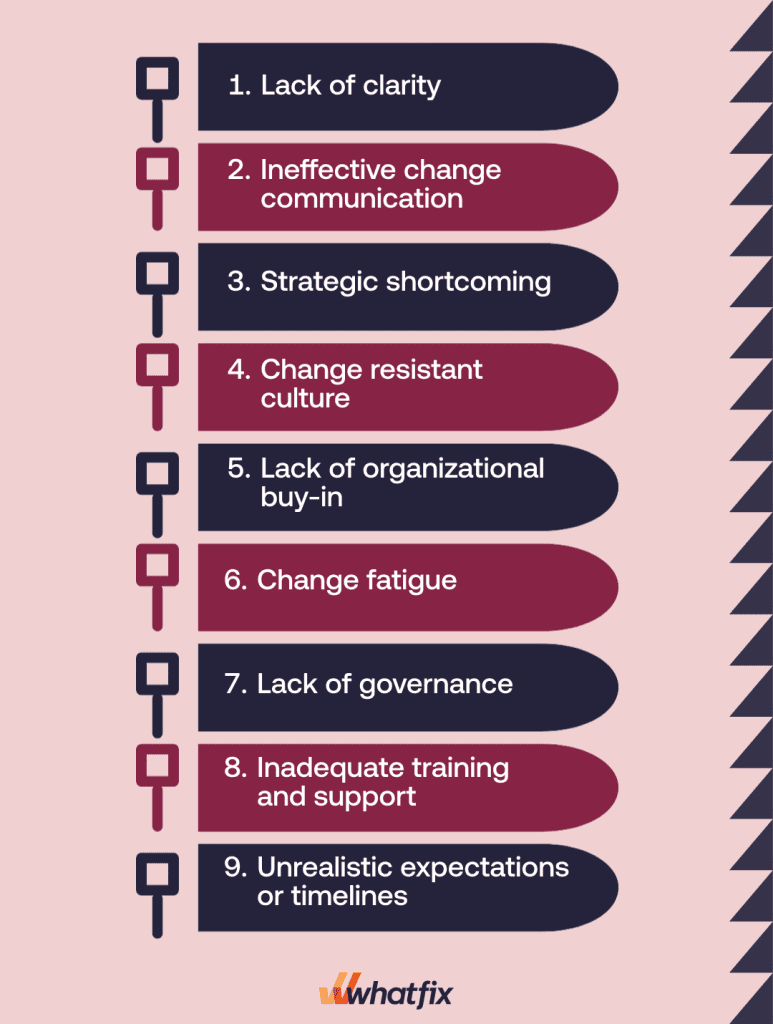
7 Barriers to Organizational Change (+How to Overcome Them)
- Published:
- Updated: July 10, 2024


To keep pace with a changing world, businesses continuously go through multiple organizational changes to outperform their competitors, improve productivity, and drive revenue. While there is an increase in change volumes and complexities, only one in three change management initiatives succeed.
Why are these change initiatives failing? Organizations often tend to neglect the people aspect of change management.
It’s important to humanize change. Organizations tend to underestimate the power dynamics within their org and contextual considerations, as well as downplay internal resistance to change. They address change management with a top-to-bottom approach, forgetting that change imposition is often met with pushback.
To decrease this pushback, leaders must conduct a baseline assessment to identify the barriers to change and address them for a successful change initiative.
What Are the Most Common Barriers to Change Projects?
- Lack of clarity
- Ineffective change communication
- Strategic shortcoming
- Change resistant culture
- Lack of organizational buy-in
- Change fatigue
- Lack of governance
- Inadequate training and support
- Unrealistic expectations or timelines
9 Top Barriers to Successful Change Initiatives for Organizations
Although the barriers to change might be different for every organization, we have identified the top 7 barriers to change leading to failure of the change initiative.

1. Lack of clarity
Change is often difficult if you lack a clear vision. If you are unaware of the current state of your organization, you will not be able to bring it to a desired future state. If you are unclear of the vision, the drivers of change and the implementers will lack clarity as well. It will derail the entire initiative.
If you come prepared with clear project scope and a compelling narrative, it will lead to a smoother transition. You must address the preliminary questions such as:
- Why is the change needed?
- How will it affect our current state?
- How do you expect to get there?
2. Ineffective change communication
Ineffective change communication is a major hindrance to the success of change initiatives within an organization, as it directly impacts employees’ understanding, acceptance, and engagement with the change process.
Statistically, only 68% of managers know the actual reason for organizational change. This number declines from 53% to 40% for mid-level managers and frontline supervisors. Gartner suggests that due to poor change communication, 73% of employees experience moderate to high-stress levels, and the affected employees perform 5% less than an average employee.
Instead of announcing the changes and expecting employees to adjust, try working on an effective communication strategy, that is, creating a two-way dialogue where employees feel heard and involved. This helps foster a positive and inclusive atmosphere conducive to successful change.
3. Strategic shortcomings
As a leader, consider this: is your strategy detailed enough to serve as a helpful guide throughout the transition?
When a change initiative needs a well-defined strategy, it often needs clearer objectives, adequate resource allocation, and poorly defined success metrics. This vagueness can lead to misdirected efforts, where the energy and resources of the organization are not optimally utilized, resulting in inefficiencies and diminished impact.
A holistic change management approach must address the following key aspects:
- the need for change
- resources for change management
- leadership support
- risks associated with the change
- realistic timelines
- training & support
- measurable KPIs
- feedback
4. Change resistant culture
The longer a current process has been in the organization, the more invested employees are in it. The status quo always feels comfortable, creating a lot of inertia in the organization. During change implementation, other cultural issues like internal politics, poor behavior control, and personal agendas start surfacing, contributing to a change-resistant culture. In such an environment, employees are likely to be skeptical about the benefits of change, leading to low engagement and even active opposition.
Leaders in such organizations face the dual challenge of managing the practical aspects of change while also working to shift the organizational mindset and culture towards a more open, flexible, and change-ready state. Without addressing this cultural resistance, even well-planned change initiatives are at risk of failure or suboptimal outcomes.
To overcome this barrier, change leaders must map the stakeholders impacted by the change and involve them in the change initiative process. Leaders need to focus on individual transition and making the environment conducive to change.
5. Lack of organizational buy-in
It is rightly said, “Change starts at the top but happens at the bottom.”
For a successful change initiative, you need to earn buy-in from both top management and entry-level employees.
The top management buy-in is essential to add legitimacy to the change initiative. Their job is more than just sponsoring the initiative; it is to take the onus of the change and lead by example. However, mid- and entry-level employees must be on board to implement the change at the ground level. When employees understand and believe in the necessity and value of the change, they are more likely to be motivated, engaged, and cooperative, making the transition smoother and more effective.
6. Change fatigue
More often than not, organizations have multiple change projects in the implementation stage at one time. When change occurs in an organization simultaneously, it overwhelms the employees. This results in change fatigue.
Change fatigue manifests in burnout, apathy, and frustration – all of which result in lower employee engagement and productivity. Prioritization of change management is the key to deal with this barrier to change.
7. Lack of governance
Investment in change is expensive, and this barrier to change can be costly to your organization. For any transformational change; you need to have a clear line of sight governance to manage the change from both a micro and macro level.
For disciplined management of the entire program, it is advisable to follow the accelerated implementation methodology. This methodology is easily scalable for projects of any size and complexity, from operational changes to transformational changes
8. Inadequate training and support
Inadequate training causes employees to need more skills, knowledge, and confidence to navigate the changes. This leads to clarity, errors, and increased productivity. This gap in training can result in a lack of engagement with the change process and even foster resistance, as employees might feel overwhelmed or unsupported.
Furthermore, inadequate training can lead to a more extended adjustment period, increased reliance on support resources, and potential disruptions in day-to-day operations.
Practical training is crucial for ensuring that employees are well-prepared to handle new challenges and responsibilities, and for fostering a positive attitude towards the change. It also plays a vital role in ensuring that the intended benefits of the change initiative are realized fully and efficiently.
9. Unrealistic expectations or timelines
Ambitious goals, while inspiring, can often lead to undue pressure on teams, resulting in rushed and substandard implementation efforts. When timelines are too tight, there is insufficient time for adequate planning, training, and adjustment, all crucial elements for a smooth transition. This can lead to employee burnout, lower morale, and resistance to change, as employees feel overwhelmed by the pace of the expected transformations.
Additionally, unrealistic timelines can undermine the initiative’s credibility, as repeated failures to meet deadlines can erode trust in the change process. Leaders need to set achievable goals and realistic timelines that allow for thorough execution, unforeseen challenges, and adequate adaptation periods, ensuring a more sustainable and effective change initiative.

How to Overcome Change Management Barriers
Now that you have identified the barrier that is withholding your organization’s change management success, let’s find an answer to another important question – how do you overcome these barriers to change?
The following tips will help you in implementing change better.
1. Strategize with the ADKAR Model
The ADKAR Model of Change Management is an outcome-oriented change management method that aims to limit resistance to organizational change. It breaks down the change process into five sequential steps: Awareness, Desire, Knowledge, Ability, and Reinforcement.
Firstly, it emphasizes the importance of creating Awareness about the need for change, which helps in understanding its rationale. Then, it focuses on building Desire among employees to support and participate in the change, which is crucial for overcoming resistance.
The third step, Knowledge, involves providing the necessary training and information to implement the change. Following this, Ability ensures that employees have the skills and resources to make the change happen effectively. Lastly, Reinforcement solidifies the change by embedding new practices and behaviors, preventing regression to old ways.

By addressing these areas, the ADKAR model ensures a comprehensive and structured approach to change management, increasing the likelihood of its acceptance and long-term sustainability.
2. Create a communication plan
Creating a comprehensive change announcement plan is a critical enabler of successful change initiatives, as it ensures that all stakeholders are informed, engaged, and aligned with the change process.
Since change is personal, you must address change management communication with consideration and empathy. By tailoring the communication to meet the needs and preferences of different audience segments, the plan ensures that the message is not only delivered but also understood and embraced. Answer the simple questions like ‘what’s in it for me?’. You can avoid ambiguity by documenting the process, the critical milestones, and the steps needed to get there.
3. Involve those most impacted by the change early in the planning process
Employees are the catalyst of change. You need to involve them early on instead of expecting them to accept the new processes. This involvement can range from participating in planning and decision-making processes to providing feedback on proposed changes. It encourages open communication, builds trust, and helps identify potential issues early on, allowing for a more collaborative and inclusive approach to managing change.
If there is a rollout of a new platform that only a core group of staff is aware of, the initiative will fail miserably. You need to check the pulse of the team and, gauge how employees feel about the change project, and act upon the received feedback.
4. Provide contextual onboarding and training for new processes or software
Providing contextual onboarding and hands-on training when implementing new software or processes is critical in facilitating successful user adoption and reducing transitional issues. Contextual onboarding, tailored to the user’s specific role and tasks significantly enhances understanding and retention of new information.
This approach helps bridge the gap between theoretical knowledge and practical application, ensuring that employees are aware of the new processes or software and competent in using them effectively. Contextual onboarding reduces the learning curve and accelerates the adoption of new systems, thereby minimizing disruption to workflows and enhancing overall productivity during the transition phase.
With a digital adoption platform like Whatfix, organizations can enable their end-users with in-app guidance and support in the flow of work. This facilitates change by providing employees with contextual onboarding and in-app training that guides technology end-users through complex processes and software – enabling them to learn by doing.
Whatfix DAP overlays on any software applications, offering real-time, in-app guidance and support tailored to the user’s specific tasks and needs. Employees receive step-by-step assistance as they navigate the new software right within the application, which helps them learn by doing.
With a digital adoption platform like Whatfix, enable your employees with in-app guidance and contextual self-help IT support to accelerate the adoption of new software implementations, employee onboarding, change initiates, and more. Whatfix’s no-code editor enables IT teams with a no-code editor to create product tours, interactive walkthroughs, task lists, smart tips, pop-ups, self-help wikis, and more. Analyze and measure user engagement and software usage to identify friction points, measure digital adoption, and improve employee digital experiences.
5. Prioritize change by opportunity
Effective prioritization involves identifying which change aspects will deliver the most significant benefits and aligning them with the organization’s strategic objectives.
This clarity ensures that the change initiative does not become overwhelming or diluted by trying to address too many elements simultaneously. It allows for a more structured and manageable approach, where resources such as time, budget, and personnel can be allocated efficiently to areas with the highest return on investment or the most critical needs.
This approach helps maintain momentum, keeps the workforce aligned and motivated, and ensures that the initiative stays on track toward achieving its intended outcomes.
6. Highlight the disadvantages of legacy processes
To shake the inertia, highlight the gaps in the current setup and the potential of the implemented change. By clearly articulating the inefficiencies, limitations, and potential risks associated with existing processes, leaders can build a compelling case for why change is needed.
This approach shifts the focus from the comfort of the known to the drawbacks and challenges that the status quo presents. It underscores the potential for improved performance, increased efficiency, and competitive advantage that new processes or technologies can offer.
7. Involve your employees
Employee involvement leads to a greater understanding and acceptance of the change, giving them a sense of ownership and empowerment.
When employees are actively engaged, they can provide valuable insights and feedback based on their experience and expertise, which can enhance the quality and applicability of the change. This approach also helps identify potential challenges and resistance, allowing for more effective strategies to address them early.
Furthermore, involving employees from the beginning in your change initiative fosters a collaborative environment where the change is viewed as a collective effort rather than a top-down imposition. This significantly increases commitment and reduces resistance, as employees feel valued and acknowledged in shaping the change that affects their work and environment.
8. Enable employees with moment-of-need performance support
Enabling employees with moment-of-need performance support involves providing them with the necessary tools, resources, and assistance just when they need it. Constant support encourages self-sufficiency, reduces learning curves, and enhances employees’ ability to adapt to new processes or technologies.
The Whatfix digital adoption platform serves as an effective tool for providing moment-of-need performance support. The platform integrates directly into your software applications, offering real-time guidance and assistance to users.
The guidance is provided via interactive, step-by-step walkthroughs, contextual tooltips, and on-screen help menus that are available to users as they navigate through new or complex tasks within the application.
Additionally, Whatfix’s personalized support can be tailored to the role and level of the user, ensuring that the assistance is relevant and practical.
With a DAP like Whatfix, creating custom interactive, branded, in-app guidance, support, and tooltips is simple. You create tooltips in the no-code Whatfix Editor that allows you to click-and-drop tooltips in your application – and then use its advanced customization feature to brand the element to your product’s theme. With a DAP, create in-app walkthroughs, product tours, user onboarding checklists, beacons, smart tips, pop-ups, field validations, self-help wikis, and more!
9. Focus on training and support
Effective training equips employees with the necessary knowledge, skills, and understanding to adapt to new processes, technologies, or strategies. It bridges the gap between the existing and desired state, ensuring that all employees are adequately prepared for the change. Comprehensive training programs not only address the technical aspects of the change but also help in managing the psychological impact it may have on employees. By investing in training, organizations can reduce resistance, increase confidence and competence among their workforce, and foster a positive attitude towards the change.
A digital adoption platform such as Whatfix provides an innovative solution for training employees during change initiatives. Whatfix enhances the learning experience by delivering interactive, on-demand training directly within the new software or application. Whatfix’s step-by-step guidance offers real-time, contextual assistance, making it easier for employees to adapt to new software or processes. The platform can also be customized to deliver role-specific training, ensuring that each employee receives the most relevant and practical guidance.
10. Monitor and measure success
Monitoring and measuring success is a crucial step in enabling and sustaining change initiatives within an organization. This process involves setting clear, measurable goals and regularly tracking progress against these objectives.
By monitoring key performance indicators (KPIs), leadership can gauge the effectiveness of the change, identify areas where the initiative is performing well, and recognize aspects that may need adjustment. This ongoing evaluation helps ensure that the change goals stays aligned with the organization’s strategic objectives and delivers the intended benefits.
Mastering change management is easier said than done. You can work to be prepared well in advance to make the transition as smooth as possible – and Whatfix can help.
Whatfix can be your partner in change to help your users or employees quickly adopt new software tools and elevate their productivity. With features like in-app support, real-time training, and behavioral insights, Whatfix makes your change management effortless.
Schedule a personalized demo with our experts to seek help in rolling changes effortlessly!
Request a demo to see how Whatfix empowers organizations to improve end-user adoption and provide on-demand customer support
Thank you for subscribing!
Thank you for subscribing!

